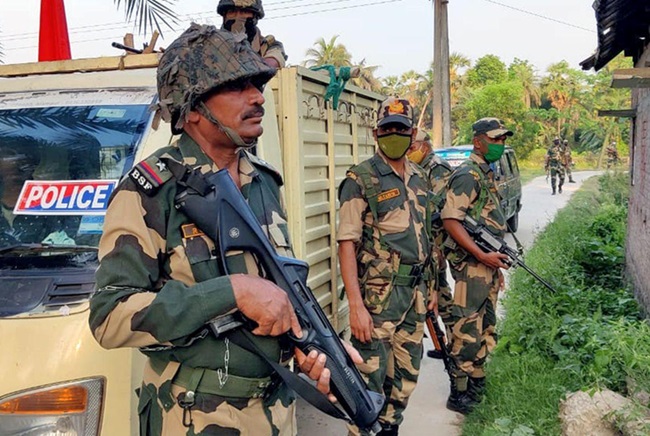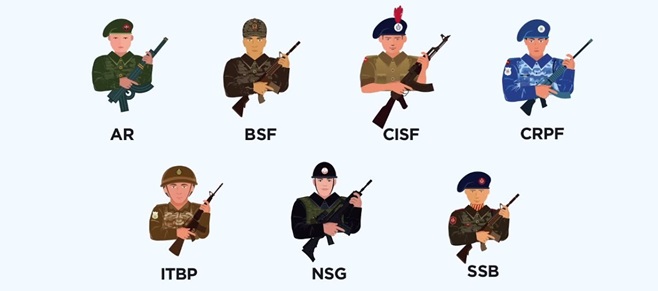Why in the news?
The Home Ministry presented data related to increasing suicide cases in paramilitary forces in Parliament.

Key points:
- Information has been shared in the Rajya Sabha that more than 700 personnel of Central Armed Police Forces, National Security Guard and Assam Rifles have committed suicide in the last five years.
- 144 in the year 2020
- 157 in the year 2021
- 138 in the year 2022
- 157 in the year 2023
- 134 in the year 2024
- In the last five years, 55,555 personnel of Central Armed Police Forces, National Security Guard and Assam Rifles have resigned or taken voluntary retirement.
- 47,891 personnel took voluntary retirement
- 7,664 resigned
Causes of suicide:
- The reasons for suicide can include both family and duty-related issues.
- According to a study, more than 80 percent of the Central Armed Police Forces (CAPF) personnel who committed suicide died after returning home from leave. The reasons include-
- Death of spouse or family member
- Marital discord or divorce
- Financial difficulties
- Inadequate educational opportunities for children; etc.
Government's efforts to solve the problem:
- Better experience on both family and duty fronts reduces stress among the jawans to a great extent.
- To deal with this problem, the Home Ministry is ensuring that more and more personnel get a chance to spend time with their families.
- Several measures have been taken for this; Such as-
- Implementing a transparent, rational and fair leave policy
- Ensuring adequate rest and leave
- Regulating duty hours
- Improving the working conditions/facilities and welfare of the Central Armed Police Forces is a constant effort of the government.
- Personnel should be able to spend 100 days per year with their families as far as possible.
- 42797 personnel of the Central Paramilitary Forces have availed the benefit of hundred days leave in a year.
What other efforts can be made?
- Transparent leave management system
- Leave should be reserved for each rank
- Leave can be provided liberally.
- Transparent transfer policy is also required.
- Promotion policy can be reviewed to boost the morale of the soldiers.
About paramilitary forces:

- They are considered responsible for the internal security of the country.
- The soldiers of paramilitary forces do not work fully as soldiers, but partially as military forces.
- All their branches work under the Home Ministry.
- The number of paramilitary forces in India is around 10 lakh.
- The Government of India currently has 7 paramilitary forces-
1. Assam Rifles (AR):
- It was established in the year 1835 by the British in the name of Cachar Levy.
- Its headquarters is in Shillong, Meghalaya.
- Assam Rifles has two main roles:
- Maintaining internal security in the northeastern regions
- Protecting the India-Myanmar border
2. Border Security Force (BSF):
- It was formed on December 1, 1965.
- It protects India's borders with Pakistan and Bangladesh.
3. Central Industrial Security Force (CISF):
- It was established on 10 March 1969.
- It is responsible for the security of the country's industrial facilities and important establishments.
4. Central Reserve Police Force (CRPF):
- It was established on 27 July 1939 in the name of Crown Representative Police.
- Its role:
- Security of VIPs and important establishments
- Keeping watch to prevent environmental degradation
- Conservation of local flora and fauna
5. Indo-Tibetan Border Police (ITBP):
- It was established on 24 October 1962.
- Its main role is to maintain peace and security on the Indo-Tibetan border.
6. National Security Guard (NSG):
- It was established on 16 October 1984.
- However, it formally came into existence on September 22, 1986.
- It is a contingency deployment force of India.
- It was created to deal with terrorism.
- NSG is also known as Black Cat
7. Sashastra Seema Bal (SSB):
- It was established in May 1963.
- It comes under the Ministry of Home Affairs.
- Its responsibility is to guard the Indo-Nepal and Indo-Bhutan borders.



